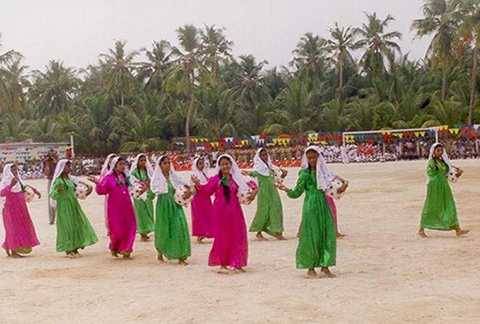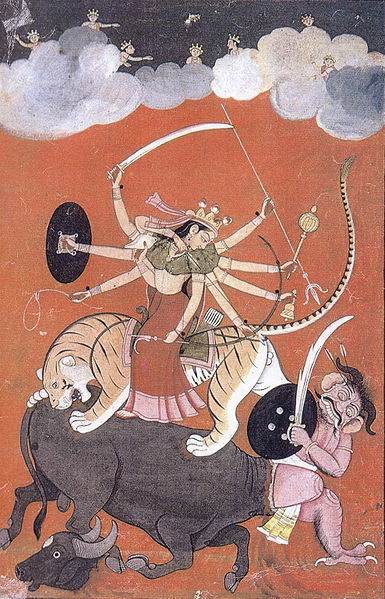from www.maldivesroyalfamily.com — in a page about maliku peoples pasttime
”The lava dance is performed by males. The dancers first line up
themselves in pairs or singles with drums and start a dance to the
beating of the drums. Then they form themselves in a circle as the dance
gains momentum. The performers are dressed in red trousers with a white
scarf tied around their waist. A smaller scarf of a contrasting colour
is worn over this. They wear a form of black and white headgear called bolufeyli. Sometimes they wear a fez cap.
The lava dance is similar to the Maldive bileh dhafi negun.
Bandiyaa jehun is a woman’s dance. Women perform this dance carrying metal waterpots on which they beat to the rhythm of their songs.”

Maliku women dancing with the bandiya. photo : maldivesroyalfamily.com
While many have written that ‘Bandiya Jehun’ is a form of Pot dance
and possibly of Indian origin few have written about the origin of the
dance which is shrouded in mystery since we have cut links with the
pre-islamic past. but the rituals have survived without the purpose of
the dance.
I dont have Xavier Romero book, but i think he will agree with me
that this dance is a devotional dance performed in Durga’s honour.
from wikipedia:
”Dandiya Raas is the traditional folk dance form of Vrindavan, India, where it is performed depicting scenes of Holi, and lila of Krishna and Radha. Along with Garba, it is the featured dance ofNavratri evenings in Western India.
Originating as devotional Garba dances, which
were always performed in Durga’s honour, this dance form is actually the
staging of a mock-fight between the Goddess and Mahishasura,
the mighty demon-king, and is nicknamed “The Sword Dance”. During the
dance, dancers energetically whirl and move their feet and arms in a
complicated, choreographed manner to the tune of the music with various rhythms. The dhol is used as well as complementary percussion instruments such as the dholak, tabla and others.
The sticks (dandiyas) of the dance represent the sword of Durga. The women wear traditional dresses such as colorful embroidered choli,ghagra and bandhani dupattas (traditional
attire) dazzling with mirror work and heavy jewellery. The men wear
special turbans and kedias, but this varies regionally.
Garba is performed before Aarti (worshipping
ritual) as devotional performances in the honor of the Goddess, while
Dandiya is performed after it, as a part of merriment. Men and women
join in for Raas Dandiya, and also for the Garba. The circular movements
of Dandiya Raas are much more complex than those of Garba. The origin
of these dance performances or Raas is Krishna. Today, Raas is not only an important part ofNavratri in
Gujarat, but extends itself to other festivals related to harvest and
crops as well. The Mers of Saurastra are noted to perform Raas with
extreme energy and vigor.”
Garba : Garba is
customarily performed by women, the dance involves circular patterns of
movement and rhythmic clapping. It popularly performed during Navratri.
The word comes from “garbha deep” which is translated as either light
in the inner sanctum of the temple or lamp inside a perforated earthen
pot (which is often used in the dance) this dance is from Gujarat.

In Hinduism, Durga (दुर्गा, “the inaccessible”[1] or “the invincible”) or Maa Durga (Mother Durga) “one who can redeem in situations of utmost distress”.[citation needed] Durga is a form of Devi, the supremely radiant goddess, depicted as having ten arms, riding a lion or atiger, carrying weapons (including a lotus flower), maintaining a meditative smile, and practicing mudras, or symbolic hand gestures.
An embodiment of creative feminine force (Shakti), Durga exists in a state of svātantrya(independence
from the universe and anything/anybody else, i.e., self-sufficiency)
and fierce compassion. Durga is considered by Hindus to be an aspect of Kali, and the mother of Ganesha and Kartikeya.[2] She is thus considered the fiercer, demon-fighting form ofShiva's wife, goddess Parvati.
Durga manifests fearlessness and patience, and never loses her sense of
humor, even during spiritual battles of epic proportion.
No comments:
Post a Comment